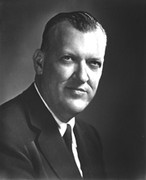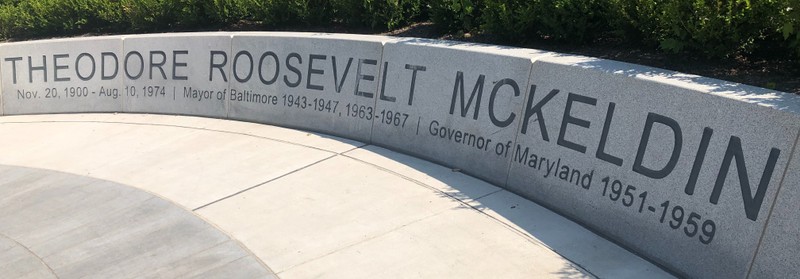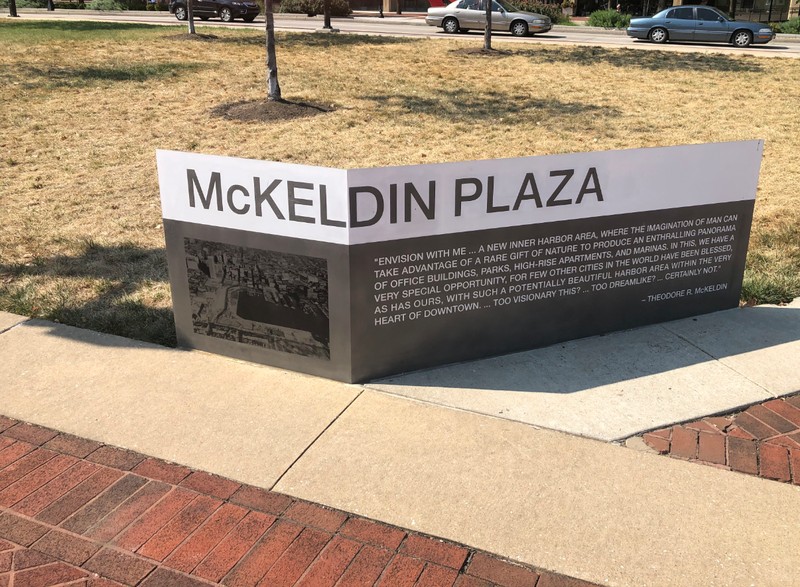McKeldin Plaza
Introduction
Text-to-speech Audio
McKeldin Plaza is named after Republican politician Theodore R. McKeldin (1900-1974), who served two terms as mayor of Baltimore (1943-1947; 1963-1967) and two terms as the governor of Maryland (1951-1959). McKeldin first proposed the idea of developing the inner harbor in 1963 to help attract tourists and revitalize the city. He was known for supporting the city's African American community and the Civil Rights movement, leading the effort to build the Baltimore-Washington Airport and the Baltimore Civic Center, and delivering the nomination speech for Dwight D. Eisenhower at the 1952 Republican National Convention in Chicago. The plaza was built in 1982 and originally had a large water fountain, which was eventually removed in 2016 as part of a plan to redesign the plaza.
Images
Theodore R. McKeldin (1900-1974), who was a Republican, served two terms as mayor of Baltimore and governor of Maryland.

The plaza was built in 1982 and originally featured a large water fountain that was removed.


Backstory and Context
Text-to-speech Audio
Theodore R. McKeldin
Theodore R. McKeldin was born on November 20, 1900 here in Baltimore. He attended local public schools and then studied law at the University of Maryland, graduating in 1925. His political career began in 1927 when he was appointed the executive secretary of Baltimore Mayor William F. Broening. McKeldin unsuccessfully ran for mayor in 1939 and governor in 1942, but won the mayoral election in 1943. Under his leadership, a new civic center and the airport were built, he successfully guided the city in a wartime economy, and appointed the first African American to the Baltimore School Board.
He ran once again for governor in 1946 but lost. Undeterred, he tried again four years later and won. McKeldin was credited with a number of accomplishments as governor including the improvement of the state's highways, the establishment of the Maryland port authority, the construction of new state office buildings in Baltimore and Annapolis, the establishment of the Patuxtent Institution (a facility to house individuals with serious mental illness and criminal history), and the creation of a commission (the Sobeloff Commission on State Government and Bureaucratic Administration) to assess the state government.
When he was Baltimore mayor for the second time, McKeldin launched an urban renew program. This included revitalizing the inner harbor as well as building a new municipal building and razing slum areas of the city. The program came at a cost, however, as it displaced three thousands of residents, most of whom were African Americans. Many businesses were uprooted as well resulting in the loss of 500 jobs. McKeldin's support for civil rights remained strong and he hosted a meeting of the Congress of Racial Equality in 1966.
In 1967 after his second term as mayor, McKeldin was appointed by President Lyndon Johnson to a panel that observed the elections in South Vietnam. The next year, he appeared before Congress to testify against capital punishment. He also founded and served as president of an organization called the America-Israel Society (McKeldin was a strong supporter of Israel since its founding). As for his personal life, McKeldin married his wife, Honolulu Claire Manzer, in 1924 and they had a son and daughter. He died on August 10, 1974 at the age of 73.
McKeldin Plaza
The plaza was completed in 1982 originally featured a large water fountain with a pedestrian bridges above the streets, cascading pools, and tall, angular concrete structures. The design was to represent the head of the Susquehanna River, which flows into Chesapeake Bay. It was also meant to block view and noise of traffic. However, the fountain was difficult to maintain and keep clean, and graffiti had to be removed regularly. Calls for its removal appear to have begun in the early 2000s. After years of planning, it was torn down and replaced in the late 2010s with a circular water feature with pores that emit mist.
Sources
"Gov. Theodore R. McKeldin." The National Governors Association. Accessed February 7, 2023. https://www.nga.org/governor/theodore-roosevelt-mckeldin/
Greenberg, Evan. "Renovated McKeldin Square to Honor Life of Revered Baltimore Mayor." Baltimore Magazine. September 26, 2019. https://www.baltimoremagazine.com/section/community/renovated-mckeldin-square-to-honor-life-of-revered-baltimore-mayor.
Hughes, Bill. "A Baltimore Original: The Late Theodore R. ‘Teddy’ McKeldin." Baltimore-Post Examiner. January 17, 2020. https://baltimorepostexaminer.com/a-baltimore-original-the-late-theodore-r-teddy-mckeldin/2020/01/17.
Lynch, Kevin. "Construction Underway on New Water Feature at McKeldin Square." SouthBmore.com. September 3, 2019. https://www.southbmore.com/2019/09/03/construction-underway-on-new-water-feature-at-mckeldin-square.
"McKeldin Plaza." The Historical Marker Database. Accessed February 7, 2023. https://www.hmdb.org/m.asp?m=179114.
Scharmen, Fred. "A look at how McKeldin Plaza came to be, and the plans to undo it all." The Baltimore Sun. August 31, 2016. https://www.baltimoresun.com/citypaper/bcp-083116-feature-mckeldin-20160831-story.html.
"Theodore R. McKeldin Papers." University of Maryland Libraries. Accessed February 7, 2023. https://archives.lib.umd.edu/repositories/2/resources/1051.
The Historical Marker Database
